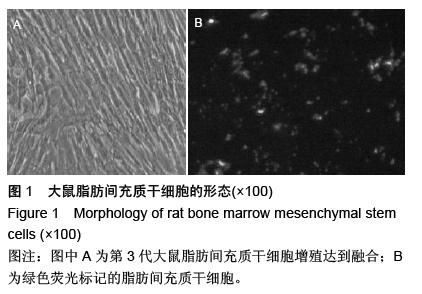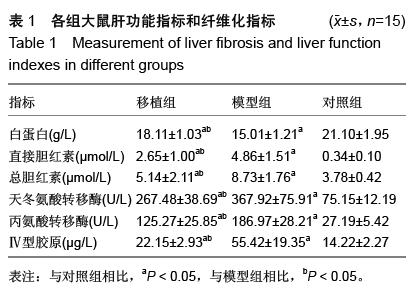| [1] 郑敏,陈聪,赵雅萍,等.探讨大鼠肝硬化动物模型的建立方法[J].肝胆外科杂志,2006,12(2):136-137.
[2] 杨静,朱萱,王河.拉米夫定初始联合阿德福韦酯治疗失代偿期乙型肝炎肝硬化疗效观察[J].中南大学学报,2012, 37(12):1269-1273.
[3] Yun TJ, Jung JY, Kim CH,et al.Treatment strategies using adefovir dipivoxil for individuals with lamivudine-resistant chronic hepatitis B.World J Gastroenterol. 2012;18(47):6987-6995.
[4] Wong GL, Chan HL, Mak CW,et al.Entecavir treatment reduces hepatic events and deaths in chronic hepatitis B patients with liver cirrhosis.Hepatology. 2013;58(5): 1537-1547.
[5] 黄越龙,周春光,张谊,等.IFN-γ对肝纤维化大鼠TGF-β1/Smad3蛋白表达的影响[J].肝胆胰外科杂志,2012, 24(1):57-59.
[6] 张莎莎,吕文良,张旭,等.肝纤维化的治疗研究进展[J].浙江中医药大学学报,2012,36(4):471-475.
[7] 郑志丰,罗利飞.苦参素对肝炎后肝硬化患者外周血Th1/ Th2的平衡和肝纤维化指标的影响[J].海峡药学, 2012, 24(2):117-118.
[8] 玉顺子.叶下珠及其制剂药理作用及临床应用研究进展[J].中国药业,2010,19(7):87-88.
[9] 张莎莎,吕文良,张旭,等.单味药治疗肝纤维化研究进展[J].辽宁中医药大学学报,2012,14(7):77-79.
[10] 倪春艳,郑仕中,陆茵,等.以瘦素为靶点中药单体成分防治肝纤维化研究策略及进展[J].中草药,2011,42(9): 1837-1841.
[11] 李丰衣,赵敏,李文刚,等.双虎清肝颗粒联合恩替卡韦片治疗HBeAg 阳性慢性乙型肝炎48 周疗效观察[J].传染病信息,2012,25(4):232-234.
[12] 李广松,赵丹.安络化纤丸治疗肝纤维化的疗效观察[J].中国社区医师:医学专业,2011,13(13):202-203.
[13] 陈大为,毕京峰,董漪,等.中西医结合治疗乙型肝炎策略的重心仍应在调节免疫[J].传染病信息,2011,24(4): 252-254.
[14] 于莉英,武晓群,王旭东.体化治疗-中西医结合的切入点[J].中华中医药杂志,2011,26(12):2784-2786.
[15] 单云峰,周伟平,杨文,等.大鼠肝卵圆细胞的分离培养和体外分化研究[J].中华实验外科杂志,2005,22(8):925-927.
[16] Burt RK, Loh Y, Pearce W,et al.Clinical applications of blood-derived and marrow-derived stem cells for nonmalignant diseases.JAMA. 2008;299(8):925-936.
[17] Li Q, Zhou X, Shi Y,et al.In vivo tracking and comparison of the therapeutic effects of MSCs and HSCs for liver injury.PLoS One. 2013;8(4):e62363.
[18] Chivu M, Dima SO, Stancu CI,et al.In vitro hepatic differentiation of human bone marrow mesenchymal stem cells under differential exposure to liver-specific factors.Transl Res. 2009;154(3):122-132.
[19] Abdel Aziz MT, Atta HM, Mahfouz S,et al.Therapeutic potential of bone marrow-derived mesenchymal stem cells on experimental liver fibrosis.Clin Biochem. 2007; 40(12):893-899.
[20] 曹会娟,林炳亮.骨髓间充质干细胞在肝硬化中的应用研究进展[J].新医学,2011,42 (1):57-60.
[21] Saito T, Tomita K, Haga H, et al.Bone marrow cell-based regenerative therapy for liver cirrhosis.World J Methodol. 2013;3(4):65-69.
[22] Sakaida I.Autologous bone marrow cell infusion therapy for liver cirrhosis.J Gastroenterol Hepatol. 2008;23(9):1349-1353.
[23] Kakinuma S, Tanaka Y, Chinzei R, et al.Human umbilical cord blood as a source of transplantable hepatic progenitor cells.Stem Cells. 2003;21(2): 217-227.
[24] Li T, Yan Y, Wang B,et al.Exosomes derived from human umbilical cord mesenchymal stem cells alleviate liver fibrosis.Stem Cells Dev. 2013;22(6): 845-854.
[25] Hong J, Jin H, Han J,et al.Infusion of human umbilical cord?derived mesenchymal stem cells effectively relieves liver cirrhosis in DEN?induced rats.Mol Med Rep. 2014;9(4):1103-1111.
[26] Thomson JA, Itskovitz-Eldor J, Shapiro SS,et al. Embryonic stem cell lines derived from human blastocysts.Science. 1998;282(5391):1145-1147.
[27] Shamblott MJ, Axelman J, Littlefield JW, et al.Human embryonic germ cell derivatives express a broad range of developmentally distinct markers and proliferate extensively in vitro.Proc Natl Acad Sci USA. 2001; 98(1):113-118.
[28] 章静波,宗书东,马文丽.干细胞[M].北京:中国协和医科大学出版社,2003.
[29] Eglitis MA, Mezey E.Hematopoietic cells differentiate into both microglia and macroglia in the brains of adult mice.Proc Natl Acad Sci U S A. 1997;94(8):4080-4085.
[30] Castro RF, Jackson KA, Goodell MA,et al.Failure of bone marrow cells to transdifferentiate into neural cells in vivo.Science. 2002;297(5585):1299.
[31] Wagers AJ, Sherwood RI, Christensen JL,et al. Little evidence for developmental plasticity of adult hematopoietic stem cells.Science. 2002; 297(5590): 2256-2259.
[32] Jiang Y, Jahagirdar BN, Reinhardt RL,et al. Pluripotency of mesenchymal stem cells derived from adult marrow.Nature. 2002;418(6893):41-49.
[33] Wurmser AE, Gage FH.Stem cells: cell fusion causes confusion.Nature. 2002;416(6880):485-487.
[34] Beltrami AP, Urbanek K, Kajstura J, et al.Evidence that human cardiac myocytes divide after myocardial infarction.N Engl J Med. 2001;344(23):1750-1757.
[35] 卢昆云,杨晋辉.干细胞移植治疗肝硬化的移植途径及优缺点比较[J].临床肝胆病杂志,2011,27(11):1226-1232.
[36] Amer ME, El-Sayed SZ, El-Kheir WA,et al.Clinical and laboratory evaluation of patients with end-stage liver cell failure injected with bone marrow-derived hepatocyte-like cells.Eur J Gastroenterol Hepatol. 2011;23(10):936-941.
[37] Kharaziha P, Hellström PM, Noorinayer B,et al. Improvement of liver function in liver cirrhosis patients after autologous mesenchymal stem cell injection: a phase I-II clinical trial.Eur J Gastroenterol Hepatol. 2009;21(10):1199-1205.
[38] 陈海鸥,胡晓宣,刘红娟,等.脐血干细胞移植治疗肝硬化的疗效观察[J].肝脏,2010,15(2):81-83.
[39] 梁丽,顾福嘉,黄国美,等.脐血干细胞移植治疗失代偿期肝硬化效果观察[J].郑州大学学报:医学版,2014,49(4): 552-555.
[40] 孙超,范建高.干细胞移植治疗失代偿期肝硬化的临床研究[J].胃肠病学和肝病学杂志,2011,20(12):1081-1083.
[41] 廖金卯,胡小宣.脐血间充质干细胞移植治疗肝硬化的研究进展[J].世界华人消化杂志,2013,21(6):508-513. |
.jpg)



.jpg)
.jpg)
.jpg)